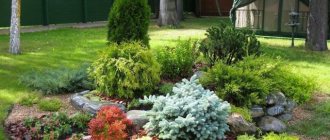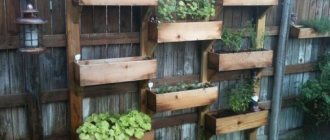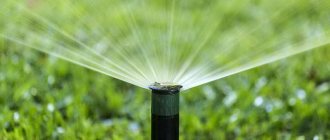Aubrieta, or aubretia, is a flowering groundcover perennial. It is placed in rock gardens, on rocky paths in the garden. The plant produces many small simple flowers of white, blue, lilac, crimson or lilac, resembling a lush cloud. Aubrieta is propagated by seeds, sowing and growing seedlings at home several weeks before planting in the ground.
Dear readers! For you, we have created communities on social networks in which useful articles and interesting ideas are published several times a day! Subscribe and receive useful content in a convenient format!
How to determine the time of sowing aubriet?
The perennial can be sown not only for seedlings, but also directly into the ground in the fall. The seeds are scattered over the garden bed at the end of October, so that seedlings do not appear before frost. Next spring, the aubrieta will show its leaves. The disadvantage of this planting option is the low germination of the plant.
To obtain seedlings, the ground cover is sown at the end of February - in March, 2-2.5 months before transplanting the bushes to a permanent place.
Caring for aubrieta in the garden
Growing conditions
Growing an aubriet flower is an easy and enjoyable task. An adult plant needs watering only when there is a long drought. If you frequently water the aubrieta in normal summer weather, you can provoke an abundant growth of greenery to the detriment of flowering. Young plants need more frequent watering than mature ones, but even here moderation must be observed. The best way to water aubrieta is by sprinkling. After watering or rain, the soil in the flowerbed needs to be loosened and weeded.

During the growing season, it is recommended to mulch the soil in the flowerbed 2-3 times with a layer of sand 3-5 cm thick. In the spring, before flowering, and in the fall, the aubrieta is fed with a solution of complete mineral fertilizer for perennial flowering plants.
Caring for aubrieta involves pruning the plant after spring flowering almost to the level of the surface of the site - this measure promotes the growth of new shoots with fresh, bright foliage, which will be an excellent background for other flowers in the flowerbed or in the rock garden until the time comes for the aubrieta to bloom again .
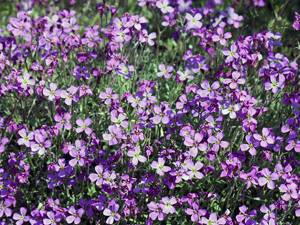
Reproduction of aubrieta
As you can see, planting and caring for an aubriet flower is not difficult and does not require much effort. The plant can also be propagated simply by cuttings and seeds. We have already told you about the seedling method of growing aubrieta. But experienced gardeners prefer to sow aubrieta directly into the flowerbed.
Sow the seeds in well-moistened soil, dug to a depth of 15 cm, cleared of stones and weeds and seasoned with complex fertilizer, wood ash and lime (chalk). Sowing is not done too thickly; the seeds are not buried, but covered on top with a layer of sand 3-5 cm thick, which is carefully moistened with a watering can. Spring shoots appear in 10-20 days, and seeds sown in September will sprout only next spring.
Another way to propagate aubrieta is by cuttings. After pruning the plant in mid-summer, you will have plenty of plant debris to use as cuttings. Cuttings (cuttings of stems without flowers) are planted in a greenhouse in a substrate consisting of equal parts of peat and sand, and at the end of August, when they form roots, they are transplanted to a permanent place. Before winter, the seedlings have time to take root and grow stronger. If winters in your area are too harsh or unpredictable, keep the cuttings in a greenhouse until spring.
- How to care for Syrian hibiscus
Propagation by dividing the bush is best tolerated by shaving in spring or autumn. This is a rather painful process for the plant. It is carried out according to the usual scheme: the bush is dug up, divided into parts so that each division has well-developed shoots and roots, after which the parts are planted in prepared holes. However, no matter how hard you try, a plant suffering from any transplant is unlikely to recover from such a complex procedure as dividing a bush, so we strongly recommend cuttings or seed propagation of aubrieta.
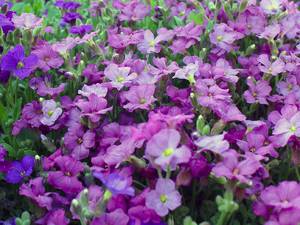
Pests and diseases
Planting and caring for aubrieta will not be a burden to anyone, especially since this plant is extremely rarely affected by diseases and pests. Sometimes aubrieta becomes infected with powdery mildew, a fungal disease, the sign of which is a whitish coating on the leaves and flowers of the plant, which becomes brown as the disease progresses. As a result of damage by powdery mildew, the aubrieta loses its decorative effect, its growth slows down, the diseased areas turn black and die, and the winter hardiness of the plant decreases. You can get rid of the disease by treating the plant with colloidal sulfur in accordance with the instructions.
Among the pests, the most dangerous for aubrieta is the aphid, a sucking insect that feeds on plant cell sap and spreads viral diseases. The pest is destroyed by treating the aubrieta with Fufanon, Karbofos, Arrivo or Biotlin. There can be from one to four treatment sessions - it all depends on the number of insects that have settled on the aubriet.
In general, aubrieta growing between stones is extremely rarely affected by diseases and pests.
Varieties of aubrieta, which one is better to choose

Of the dozen natural species of aubrieta, the most popular among gardeners are: deltoid (blue-purple flowering) and hybrid or cultivated. The latter variety has several varieties suitable for growing in the Russian climate.
- Cote d'Azur. The sky blue flowers are open during May and June, and the perennial blooms again in September. The variety is successfully used by landscape designers to imitate a waterfall or mountain river in a plant composition. The perennial of this variety is exceptionally winter-hardy.
- Enchanting Morocco. The plant is notable for its large pink or red flowers and abundant flowering.
- Cascade. The variety mixture includes almost all possible shades of perennials: purple, pink, blue, red, turquoise. There is a yellow spot in the middle of each flower. The perennial can be grown as a potted plant.
- Alix Britt. A variety with semi-double large buds, growing well in lace shade.
- Lizzie. Small-flowered fiery red aubrieta, only 12-15 cm high. Suitable for indoor growing.
Non-winter-hardy varieties of aubretia are successfully cultivated as a home flower.
The most popular types and varieties of aubrieta
Aubrieta is characterized by the presence of more than 10 species. The most common plantings carried out in summer cottages are:
- Deltoid shaving. It is a herbaceous ground cover plant whose height reaches 15 centimeters. The culture has delta-shaped foliage, gray-green in color. The edges of the leaves have several pronounced teeth. In May, racemose inflorescences are observed on the shoots. The loose racemes bear purplish-blue or lilac flowers, the diameter of which reaches 1 centimeter.
- Hybrid . Characterized by fairly rapid growth. It is a green subshrub that reaches a height of 20 centimeters. This plant is able to maintain the color of its leaves even in winter. At the end of spring, loose inflorescences are present on the foliage for 1-1.5 months. They are characterized by a lilac or soft purple color.
- Cascade . Characterized by pubescent shoots of gray-green color. This culture is widely used for decorating vertical flower beds. The culture blooms in purple, blue or turquoise from May.
- Red King . It is a spherical bush, the height of which can reach 15 centimeters. It is characterized by the presence of bright red flowers, the diameter of which can reach 5 centimeters.
You may be interested in: How to make a waterfall in the garden with your own hands: dig a pit, lay waterproofing
Photo:
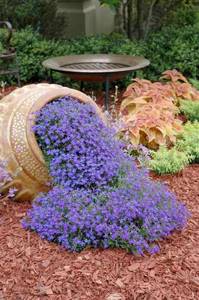
Aubrieta has a large number of varieties, which provides the opportunity to choose the most appropriate option for landscape design.
Aubrieta is propagated by seeds, which are planted in open ground in the autumn. If you plant the seeds in the spring, the bush will not bloom in the summer. Before planting seeds, it is necessary to remove weeds from the area, and also carry out high-quality loosening of the soil.
Watering seedlings should be done as carefully as possible. Experts recommend spraying the soil, which will eliminate the possibility of damage to tender young shoots.
Planting seeds can be carried out according to one effective scheme. Initially, they are kept in vermiculite for two months. In the first few weeks, it is recommended to maintain a temperature between 18 and 20 degrees.
It is recommended to cover the container with seeds with plastic wrap. It is sometimes opened to provide air access. After 8 weeks after planting the seeds, the crop is transplanted into open ground.
Photo:
You may be interested in: Rock garden: the best design diagrams and an example of making it yourself

What should the soil be like for planting?
The aubrieta should be planted in a sunny place.
Otherwise, the plant will not bloom. The choice of substrate must be approached responsibly. It should be light and barren. In this case, it is best to give preference to sandy substrates. In order to reduce the acidity of the soil, ash or lime is added to it. Peat must be used to feed the aubrieta. During the flowering period of the crop, it is recommended to apply complex mineral fertilizers.
Is it necessary to cut the shaving?
Aubrieta needs pruning. After the aubrieta blooms in the spring, it is recommended to cut off all stems at the roots. This will eliminate the possibility of excessive growth of the crop.
After pruning, the aubrieta will bloom again in the autumn. To ensure an attractive appearance of the bush, it is recommended to regularly remove shoots and leaves that have dried out. In the autumn, pruning is not carried out. Shoots that die are removed in the spring.
You may be interested in: Alpine slide with stones for a country house: we build and decorate
Photo:

When to sow aubrieta for seedlings in 2021 according to the lunar calendar?
Gardeners and gardeners know that plants sown in certain phases of the moon have high germination and growth energy. Every year, scientists compile a Lunar calendar to help farmers, which identifies favorable and dangerous days for sowing and other work.
Favorable days for sowing aubrieta in 2021, depending on the month
- In February, it is recommended to sow aubriet on the 12th, 13th, 14th, 15th, 16th, 17th, 18th, 19th, 20th, 21st, 22nd, 23rd, 24th, 25th, 26th. The moon these days is in a phase favorable for flower growth. The plants will sprout quickly and amicably, and there will be little pain.
- Favorable days for sowing aubrieta in March will be: 14, 15, 16, 17, 18, 19, 20, 21, 22, 23, 24, 25, 26,27
- Favorable days for sowing and growing seedlings in April : 13, 14, 15, 16, 17, 18, 19, 20, 21, 22, 23, 24, 25,26.
- In May , some gardeners sow aubration directly into the ground; days for planting: 12, 13, 14, 15, 16, 17, 18, 19, 20, 21, 22, 23, 24, 25.
Unfavorable days for planting and growing aubretia in 2021
You should not sow aubretia seedlings on the New Moon, Full Moon and days when the moon is in Aquarius:
- 10, 11, 27
February; - 9. 10, 11, 13, 28 Martha;
- 6,7, 12, 27 April;
- 3, 4, 11, 26 May inclusive.
On these dates there is a New Moon or Full Moon, which negatively affects plant life.
Place for growing aubrieta

Aubrieta in garden design photo
Choose your landing site carefully. The plant will be able to demonstrate its decorative potential to the maximum in the presence of bright sunlight: flowering will be abundant, the shade of the inflorescences will be saturated.
As for the soil: the poorer it is, the better for the plant. Oily, peaty, and clayey soils are not suitable - the aubrieta may not take root. Moderately fertile, loose garden soil is ideal. The reaction is preferably neutral or slightly alkaline. To reduce acidity, add wood ash or chalk.
Grows well on rocky soil (can be planted among concrete slabs, stone steps).
When to plant depending on the region
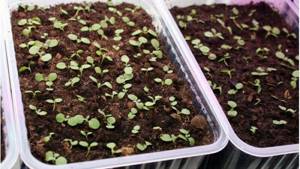
Young aubrieta bushes will not survive sub-zero temperatures, so seedlings are placed in the ground after warm weather sets in. Based on the climate of a particular area, a convenient time for sowing seeds is calculated.
In Moscow and Moscow region
Seedlings are placed in the ground here at the end of May. Under temporary film cover, seedlings are planted 10-12 days earlier. Based on the age of the seedlings ready to be transferred to the ground and the time for seed germination, sowing begins in mid-February - the first ten days of March.
In the middle zone
The region is quite vast; climatic conditions differ markedly in the north and south. The approximate time for sowing aubrieta for growing seedlings is the beginning of March.
In the Urals
Seedlings are planted in open ground in the first ten days of June. Preparing seedlings begins from March 1 to March 15.
In Siberia
In most areas of Siberia where this perennial is grown, the climate is similar to the Ural region. The dates for sowing seeds are the same - from March 1 to March 15.
In the Leningrad region
Warmth arrives in the region a little later than in Moscow, the difference is about 10 days. Accordingly, the sowing of aubrieta is carried out a decade later - in mid-March.
Aubrecia description. What does an aubriet flower look like?
The small, pubescent, elliptical leaves have a serrated or solid edge. Racemose inflorescences are formed from tiny centimeter-long flowers with 4 petals in a wide variety of shades: purple, ultramarine, lilac and coral. Rich flowering occurs at the end of spring and lasts until mid-summer. With proper care, aubrieta can bloom again in the fall. The fruit capsule in the form of a pod is filled with flat brown seeds.
Let's look in detail at how and when to plant aubrieta seeds for seedlings, care for them at home, how to properly plant and care in open ground, and look in detail at the main popular plant varieties.
Methods for propagating aubrieta
The plant can propagate in three ways: seeds, cuttings and dividing the bush. Let's look at each of them in more detail.
Growing from seeds
Sowing seeds
By propagating aubrieta by seed, it is possible to sow directly into the ground, at the beginning of autumn or at the end of spring, but in this case there is a threat of splitting of the varieties. Before sowing, you need to first prepare the soil: dig up to a depth of 15-20 centimeters, get rid of stones and weeds, fertilize the flowerbed with crushed chalk and wood ash, then lightly moisten it. Planting of seeds occurs directly on the surface at some distance from each other. Sprinkle the top 3-5 centimeters with sand and water it. Seeds sown in spring will produce the first shoots in half a month, and autumn seedlings will appear only next spring.
Experienced gardeners advise using the seedling method of growing from seeds. The best time to sow seeds for seedlings is the last days of February.
Sowing is done in a mixture of peat and humus in a small container or in special peat pots. It is most convenient to grow seedlings in such containers; firstly, it provides the plant with nutritional value, and secondly, young shoots are planted in open ground directly in them, which significantly reduces the likelihood of damaging the root system of the plant. The seed is placed on top of the moistened soil mixture, about 2-3 seeds per pot, and then lightly sprinkled with sand. From above, the sand is moistened with a spray bottle and removed under a transparent covering material in a warm place with an average air temperature of 18-20 degrees.
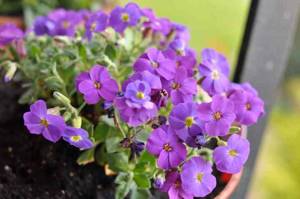
Seedling care
Caring for aubretia seedlings is quite simple. It is necessary to provide it with daily ventilation and watering as needed. Young shoots will appear 25-30 days after sowing. As soon as the first green leaves appear, the protective covering must be removed. Aubrieta seedlings do not tolerate large excesses of moisture, so you should not overdo it with watering. To help the plant get stronger before planting in open ground, you can feed it with a weak solution of complex mineral fertilizer.
The windbag perceives any transplantation extremely negatively, which is why the plant is immediately sown in separate containers and sits in them until planting in a flowerbed, without picking.
Planting aubrieta in open ground
Before planting in open soil, you should decide on the location. It must be sunny for the windblown to delight with impressive abundant flowering. The sunny side of the garden is best, where the plants will be in direct sunlight most of the day.
The time for planting comes immediately after the last frost. Usually this is April - May.
In terms of soil, aubration is absolutely unpretentious. On the contrary, the poorer the soil, the better it feels. However, it is still worth observing a few simple conditions when preparing the soil. Firstly, it must be loose and provide good drainage, and secondly, it must be enriched with peat or ash. In terms of composition, neutral or slightly alkaline soil is preferable.
The aubriet flower is highly elastic. Therefore, the form of landing depends entirely on your imagination. Even landing on rocky rock gardens is allowed. The depth of the hole depends on the length of the rhizome; the width should be ½ greater than the width of the pot with the seedling. If you are growing seedlings in a plastic or ceramic container, you need to immerse it in water until bubbles appear on the surface. Then carefully remove the seedling and place it in the hole at a distance of 5 cm from another bush. The top of the soil is sprinkled with sand and slightly moistened.
Reproduction by cuttings
Cuttings are also a fairly common method of breeding aubrieta. Usually in mid-summer the flower is cut off, after which there is a lot of material for planting. Flowerless trimmed shoots are placed in a greenhouse or greenhouse in sandy-peaty soil. By the end of summer, the plant will be sufficiently rooted to move into open ground, thus, by the time frost sets in, the cuttings will be sufficiently rooted. But if the climate in your region is famous for its little snow or harsh winters, then you can leave the seedlings in a greenhouse until spring.
Reproduction by dividing the bush
Dividing the bush can be done in summer and autumn. First, you need to dig up an aubretia bush and divide it into equal parts so that each of them has healthy, strong roots and shoots. Then, the resulting bushes are planted in separate holes, the soil around the rhizome is compacted and watered.
Attention! The propagation method by dividing the bush is extremely ineffective, since the aubrieta tolerates it very poorly and the planted bushes rarely take root.
Perennial aubrieta - garden
Caring for a shaving is a simple process that does not require much time or effort. For full development and lush flowering, you just need to follow a few simple rules.
Watering
Mature flowers should only be watered during severe drought to avoid excessive greening to the detriment of the plant's flowering. Young shoots should be watered a little more often until they are completely rooted. After watering, be sure to loosen the soil and remove weeds in a timely manner.
Attention! In dry summers, to avoid drying out of the root system, you can scatter grass under the bushes of the plant.
Top dressing
During the period of active growth and flowering, the surface of the soil around the bushes is sprinkled with sand to a depth of 3-5 cm to retain the necessary moisture. Fertilizer is done only twice a season - in the spring, before flowering begins, and then after pruning the plant with any complex mineral fertilizer containing potassium.
Trimming
For abundant flowering, it is necessary to pick off faded flowers. After spring flowering, the aubrieta is cut off, almost to the root. This measure will lead to repeated flowering during the season.

Collecting seeds
To collect aubrieta seeds, after pruning, you need to leave several shoots on the bush with the ovary. After the seed pods darken, you can cut them off, remove the seeds and ventilate them thoroughly. After these manipulations, the seeds are ready for sowing.
Preparing aubretia for wintering
When the windblown blooms for the second time in a season, pruning should not be done in the fall. The stems and leaves of the plant will serve as a reliable shelter for it during the winter cold. In case of a harsh winter, it is recommended to provide the flowers with additional shelter, which can be dry leaves and spruce branches.
Diseases and pests
Aubrieta is practically not afraid of viral infections and pest attacks. The worst enemy of a flower is overwatering the soil.
Rarely, powdery mildew can affect a windbag. This disease manifests itself as a white coating on the leaves. As the disease progresses, the plaque becomes brown, and the affected areas of the plants turn black and die. An effective means of combating this disease is colloidal sulfur.
The most common insect that attacks this plant is aphids. The parasite feeds on plant sap, spreading dangerous viral infections. Karbofos and similar drugs will help get rid of it.
How to choose a container for planting?
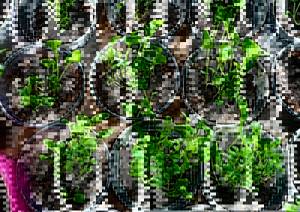
The perennial is very difficult to transplant, so it is better to sow it in a separate container. An excellent solution is peat cups or tablets. Soaked in fertilizers and absorbed water, the tablets become a favorable environment for the growth of the flower's root system. When planted in a garden bed, the roots of the plant are not damaged during cultivation.
ON A NOTE. For obrieta, choose tablets with a diameter of 3-4 cm. A pot is enough for 200 ml.
When sowing in common boxes, adhere to sparse planting, leaving a distance of 3-4 cm between the seeds. This scheme will allow you to avoid picking when growing.
Growing from seeds
To speed up the flowering process of aubretia, first, seeds are sown for seedlings at home, and only then the strengthened seedlings are transferred to a permanent place of growth.
Seeding
It is better to purchase aubretia seed material from a flower shop that has certificates of conformity of varieties. It must be remembered that aubrieta grown from seeds will bloom only next year. They begin planting seeds at the end of February, when there are 2-2.5 months left before the onset of warm weather. These dates may vary slightly in different regions.
The best options for sowing a flower are peat tablets, then you don’t have to pick seedlings from a common container and transfer them to flower beds. It is enough to plant it together with a peat pot, this will prevent injury to the delicate roots of the aubration.
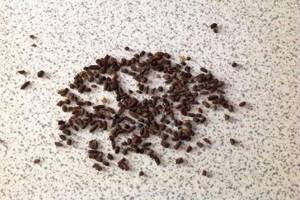
First, the tablets are filled with water and waited for them to swell. After this, 2-3 flower seeds are placed on the surface of each. A layer of steamed river sand 3-4 mm thick is poured on top. Spray the top with warm water from a spray bottle with small holes and cover with plastic wrap and glass. The most suitable temperature for germination of aubretia seeds is considered to be in the range from 18 to 21 degrees.
Seedling care
After green sprouts appear, the film or glass is removed daily for several hours so that the flowers are ventilated. As soon as they get a little stronger, the coating can be removed altogether. You need to be very careful when watering seedlings; aubretia does not like stagnant liquid and can get sick. 2-3 weeks before planting seedlings in a permanent place, feed the plants with complex mineral fertilizer, but use a weak concentration. If the sprouts look strong and grow quickly, skip this stage altogether.
Picking
Aubrecia tolerates the process of seating in separate containers extremely negatively. If, nevertheless, the seeds were sown not in separate peat pots, but in a common container, picking is carried out with extreme caution. First, they spill the soil, and then carefully take out the seedlings with a teaspoon and place them in separate cups.
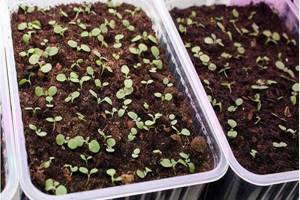
When and how to plant in open ground
The time for transferring seedlings in each region varies depending on climatic conditions. On average, this occurs at the beginning - mid-May, when consistently warm weather has established itself and the threat of return frosts has passed. In the northern regions it is better to do this at the end of May.
The place planned for planting aubretia seedlings should be well lit by the sun. In the shade, the gardener will not see the abundant flowering of aubrieta that the plant is capable of. But in terms of soil, the flower does not make any increased demands. Rather, on the contrary, the poorer the soil, the more aubretia likes it. The main thing is that the soil allows moisture to pass through well and is loose. A small amount of wood ash or peat will not hurt. Soil acidity is preferably neutral or weak.
When digging holes for seedlings, take into account that their width should be twice as wide as that of the peat tablet in which the flower is located. The depth of the hole is determined by the length of the roots. Plants are placed at a distance of 5 cm from one another. After planting, crush the soil with your hands and mulch the surface with a 5-centimeter layer of sand, after which it is moistened abundantly.
See also
Types and varieties of spirea with descriptions and characteristics, growing rulesRead

Planting aubrieta with seeds step by step
Seedling soil is prepared from a mixture of peat soil (1 part), turf soil (2 parts), river sand or perlite (3 parts). For every 5 liters of substrate add 0.5 cups of wood ash and 2 tsp. ground shells or bone meal. Mineral fertilizers are not applied to the soil.
- Before sowing, the soil surface is moderately moistened, compacted and sprinkled with sand.
- The seeds are small, they are distributed evenly over the soil, being careful not to place them close to each other.
- The spread out seeds are sprinkled with warm water.
The crops are covered with film to retain moisture and left in the light at a temperature of +22 degrees. Germination can be expected from 7 to 28 days.
IMPORTANT! It is necessary to monitor soil moisture by periodically spraying the soil surface.
Growing aubrieta aubretia from seeds at home
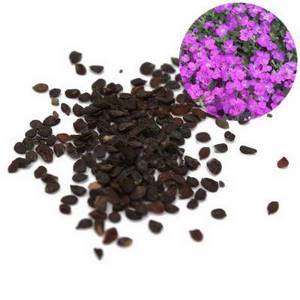
Aubrieta aubretia seeds photo
Aubrecia reproduces well by seeds. Most often, aubrieta is grown through seedlings.
- Start sowing seedlings around the end of February.
- Seedlings do not need picking or intermediate transplantation - sow immediately in individual containers.
- Peat-humus pots or peat tablets are perfect.
- Moisten the soil, place 2-3 seeds on the surface, sprinkle with sand (layer no more than 0.5 cm), and also moisten the sand cushion with a fine spray.

Aubrieta planting seeds photo seedlings
- Cover the crops with glass or film, germinate in diffused light, ensure the air temperature is within 18-21 °C. Ventilate the crops daily.
- Expect the emergence of seedlings within 3-4 weeks - when they appear, the cover can be removed.
- Water the soil with caution, avoiding waterlogging.
- If the sprouts develop poorly, a couple of weeks before transplanting into open ground, feed them with complex mineral fertilizers (keep the concentration low).
Plant aubrieta seedlings in open ground when the threat of return frosts has passed. Pre-harden the seedlings.
How to care for aubrieta seedlings, what are the tricks?
Excessive soil and air moisture can destroy a perennial, so it is important for the gardener to strictly dose watering. It is advisable to moisten the soil through a tray. The soil surface is left dry. If watering from above, use a pipette or syringe, directing the stream away from the sprouts.
Basic parameters for growing seedlings:
- air temperature +20 degrees;
- lighting for 12-14 hours.
To prevent the development of rot, seedlings are watered with a solution of potassium permanganate or Fitosporin every 10-15 days.
The aubrieta seeds have sprouted, what to do next?

After the sprouts appear, the cover is removed from the crops. The soil is sprinkled with dry sand mixed with ash, without touching the seedlings. This technique prevents the appearance of rot and mold.
How to feed aubrieta seedlings?
Use only a mineral complex intended for flowering perennials (Kemira, Agricola). The concentration of the nutrient solution is twice as weak as recommended in the instructions. The frequency of fertilizing is once every 10 days, starting from the seedlings being one week old.
Rules for picking aubrieta
The plant does not tolerate transplantation well, so it is grown without picking. If such a need arises, the seedlings are picked up with a fork, along with a lump of earth. They are transplanted into a new substrate without destroying this lump.
Plant care
If you have succeeded in growing and transplanting seedlings, further care of your shrub will not require any effort.
Watering and loosening
Adult plants are quite unpretentious; they can survive without moisture for a long time.
- Only young shoots need to be watered regularly until they take root in a permanent place.
- An adult aubercia with excess moisture will produce more greenery than flowers, so it needs to be watered once a week in normal weather and twice a week in hot and dry periods.

The optimal method of watering is sprinkling
The soil under the flowers must be regularly weeded and loosened. But it is better to fill the soil around the bushes with sand so that the root moisture does not quickly evaporate and the soil does not become compacted from water.
Feeding and pruning
The plant is not fed often. This can be done twice per season - in early spring and autumn. For this purpose, liquid mineral fertilizers are used for perennial flowering plants.

Each drug has its own dilution proportions, they are indicated on the packaging
Advice. If the soil is very poor, the aubrieta can be fed with nitrogen in early spring, and with potassium before flowering begins.
After flowering ends, it is necessary to cut off all shoots almost to the root. Thanks to comprehensive pruning, the plant will begin to actively grow new stems, becoming even more magnificent.
And until autumn you will be provided with a dense green carpet of openwork leaves, perfectly shading other flower crops.

Aubrieta quickly grows shoots, forming a green carpet
Collecting seeds
It is better to buy aubercia seeds in specialized stores, this guarantees the presence of all varietal properties. Which may be partially lost when propagated by seeds collected from existing plants.

The packaging contains a description of all varietal characteristics and recommendations for growing
But if such a need arises, then when pruning the bushes, several shoots with ovaries are left. Ripe pods become dry and dark. They are cut, the seeds are husked and dried.
You can sow them this same fall directly into the ground using the method already described above.
Preparing for winter
After autumn flowering, the aubrieta is not pruned. All shoots, leaves and flowers are left untouched, so that after the snow cover melts, it will delight you with fresh greens.

Aubrieta in early spring
If the winters in your region are snowy, adult plants can winter quietly without additional shelter. In the absence of snow and low temperatures, they may die. In this case, the plantings are covered with spruce branches and covered with dry leaves to protect them from freezing.
With the onset of spring thaws, the shelter is removed.
Diseases and pests
Aubrieta is very resistant to common diseases of garden crops. It can only become infected with powdery mildew, which manifests itself by the formation of a white coating on flowers and leaves, which darkens over time.

The first sign of powdery mildew is the appearance of a white coating.
If measures are not taken, the plant loses its decorative effect and begins to gradually fade and turn black. Spraying with a solution of colloidal sulfur, which is carried out several times, will help save it.
It is better to immediately cut out and burn the most damaged shoots.
The main and most dangerous pest of this plant is aphids, which feed on cell sap. She often becomes a carrier of viral diseases. Aphids hide on the inside of leaves, so they may not be immediately detected.
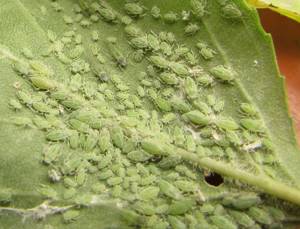
Leaf affected by aphids
It is quite simple to destroy the pest by treating the plantings with insecticidal preparations such as Karbofos or Fufanon.

Fufanon - a drug for controlling garden pests
Answers to frequently asked questions

All novice gardeners face the same problems when growing aubrieta from seeds. Common mistakes and popular questions are discussed below.
What soil should I buy for growing seedlings?
Aubrieta needs neutral or slightly alkaline soil, with a high percentage of sand. Suitable soil for succulents and palm trees. You can buy a universal peat substrate and add 25% perlite (sand) and 5% wood ash to it to reduce acidity.
How can you stimulate seeds for further growth?
Untreated seeds can lie in the ground for up to a month. To speed up germination, they are kept for 15 minutes in Epin solution. Instead, use aloe juice (1 tsp per glass of water).
Why don't aubretia seeds germinate?
There are two probable reasons:
- the seeds are old or immature and have lost their viability due to natural reasons;
- they were covered with soil or sand, the seedlings could not come to the surface.
Why are seeds soaked?
Soaking planting material in a stimulant solution or hot water softens the seed coat. It is easier for the sprout to break through, so shoots appear earlier.
How to harden aubrieta seedlings?
Boxes with seedlings are taken outside on a fine and sunny day. The time of the first “walk” is 30-40 minutes. Every day, exposure to air increases by an hour and a half. Before planting seedlings, they are taken home only for the night.
What to do if aubrieta seedlings do not grow?
Slow growth may be due to lack of nutrition and light. Fertilizing is carried out 3 times a month using complex fertilizer. If the seedlings still do not grow, the fertilizer concentration is increased by 30%.
Planting aubrieta in open ground
When to plant
Aubrieta is planted in a flowerbed when the return spring frosts have passed - in the second half of May. Approach the choice of site very responsibly: the aubrieta in the garden should receive maximum sunlight - only then will you be able to see truly abundant flowering of the aubrieta.
As for the soil, in this regard everything is very simple: the poorer the soil, the better for the plant. Aubrieta grows well between stone steps and concrete slabs. The soil should be loose, permeable and contain a small amount of ash or peat. As for the level of acidity, soil with a neutral or slightly alkaline reaction is preferable - pH 6.0-7.0.

How to plant
Aubrieta is a flexible plant, so you can plant it in accordance with your idea of what your flowerbed or rock garden should look like. The planting depth is determined by the length of the plant’s root system, the width of the holes is twice as large as the container in which the seedling grows. The distance between copies is at least 5 cm.
- Ludisia: home care
If you grew seedlings in a ceramic or plastic container, before planting, place it in water and hold it until bubbles begin to appear on the surface of the soil - then carefully remove the plant with a lump of earth and lower it into the hole. After planting the aubrieta, compact the soil, mulch it with a 5 cm thick layer of sand and water it carefully.





